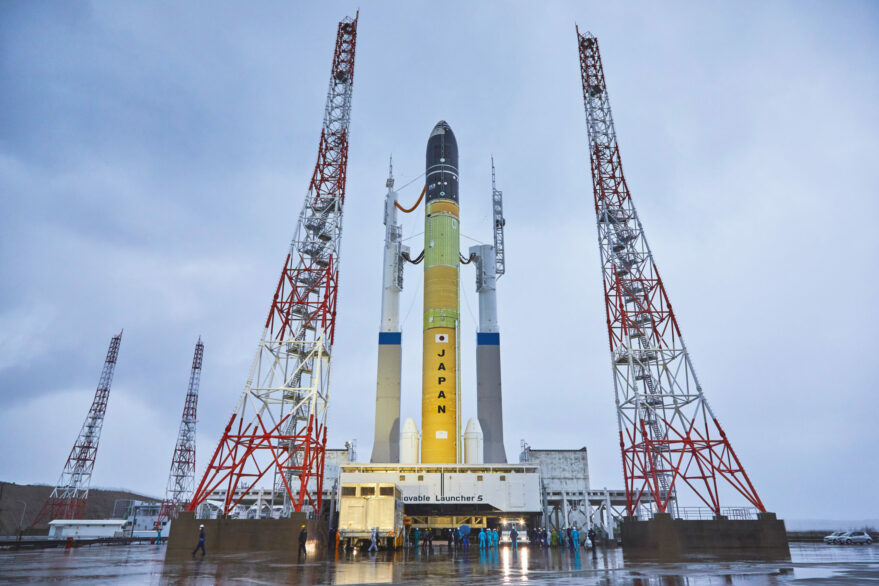TOKYO — The launch of Japan’s new workhorse H3 rocket has been postponed again as engineers continue to wrestle with engine problems first uncovered in 2020 during qualification testing.
After spending most of 2020 and all of 2021 struggling with the expendable H3’s novel LE-9 main engine, officials with the Japan Aerospace Exploration Agency (JAXA) told reporters last week that the H3 will not be ready to launch by the end of March as previously hoped.
No new date has been set for H3’s first flight, but JAXA officials said it would not occur sooner than April and hopefully no later than March 2023.
“We will talk about the revised launch schedule as soon as possible,” JAXA’s H3 project manager, Masashi Okada, said during a Jan. 21 press conference here.
JAXA and Mitsubishi Heavy Industries (MHI) are building the H3 rocket as a more flexible successor to Japan’s H-2A medium-lift launch vehicle. Like the workhorse H-2 family of rockets Japan has been using for satellite launches since the 1990s, the H3’s two-stage core is powered by MHI-built engines that use liquid oxygen and liquid hydrogen propellants.
But instead of using a single LE-7A first-stage engine and at least one pair of side-mounted solid rocket boosters (SRB) like the 20-year-old H-2A, the H3 can fly with zero, two, or four strap-on boosters and either two or three LE-9 first-stage engines in order to carry a wider range of payloads to a wider range of orbits.
The H3 rocket’s LE-9 is not only a more powerful engine than H-2A’s LE-7. It also employs a novel design, called an expander bleed cycle, that Mitsubishi was the first to introduce with its LE-5A upper stage engine.
The H3 stands to be the first rocket to use an expander bleed cycle engine for its first stage, a design choice meant to yield higher engine thrust at the expense of efficiency.
Bad vibes
Japan authorized development of the H3 rocket in 2013 and at one time hoped to conduct the first of two test launches in 2020.
But those hopes were dashed by May 2020 when problems with the LE-9 engine emerged during the H3’s qualification testing.
Engineers discovered cracked turbine blades in the LE-9’s turbopump assembly, and a hole burned into the engine’s combustion chamber wall.
JAXA and MHI got to work redesigning the engine’s fuel turbopump and decided to apply those same changes to the engine’s oxygen turbopump to be on the safe side, Okada said.
In September 2020, JAXA announced that H3’s first test flight would slip to no earlier than spring 2021.
JAXA and MHI turned their focus to the combustion chamber problem as new turbopump hardware got underway.
Okada said a series of nine combustion tests convinced JAXA that it could stick with the LE-9’s current combustion chamber design for H3’s first test flight — carrying Japan’s Advanced Land Observing Satellite-3 (ALOS-3) — by sacrificing some performance. For H3’s second test flight, carrying ALOS-4, Okada said JAXA and MHI would switch to a 3D-printed combustion chamber they think will solve the problem for good.
“We have been able to establish a workaround for the combustion chamber issue,” Okada said during the Jan. 21 press briefing, summing up the past couple years of LE-9 problems and their remedies. “For the turbopump issue, while some progress has been made, further action is needed to ensure a reliable launch.”
In January 2021, MHI shipped the H3 Flight Test-1 core stage to Tanegashima Space Center. Last March, JAXA rolled the H3 out the launchpad for a wet dress rehearsal — a practice countdown where the rocket is loaded with propellant but the engines are not ignited.
The rehearsal, which involved test versions of the first-stage engines, appeared to go well. There was no turbopump damage, but JAXA said engineers saw some potentially problematic vibrations.
By June 2021, the vibration problem improved, but a new problem — described as a turbine flutter — was found.
Work continued into the fall, with engineers installing dampers and making adjustments to eliminate vibration sources.
JAXA still doesn’t know if the redesigned turbopumps are good to go. Captive firing testing of the integrated rocket remains on hold, with no date currently set.
JAXA President Hiroshi Yamakawa said Jan. 21 that while the H3 team is not pleased to have postponed the launch a second time in as many years, “it was judged that it was necessary to take appropriate measures … before finalizing the design.”
SpaceNews staff writer Brian Berger contributed to this story from Washington.
